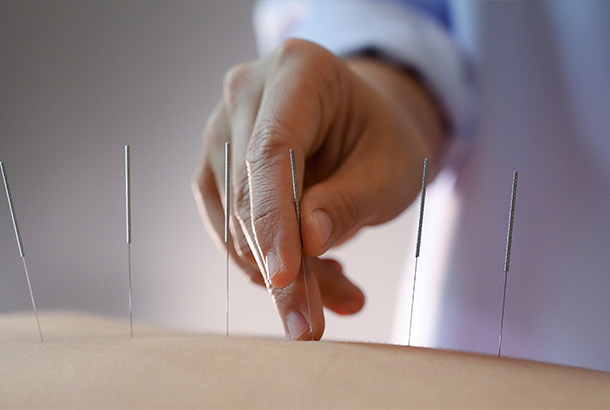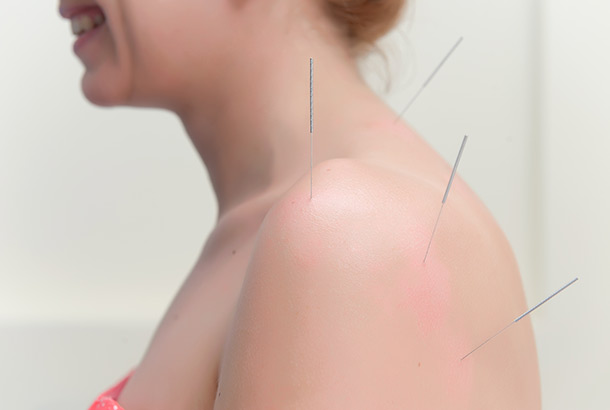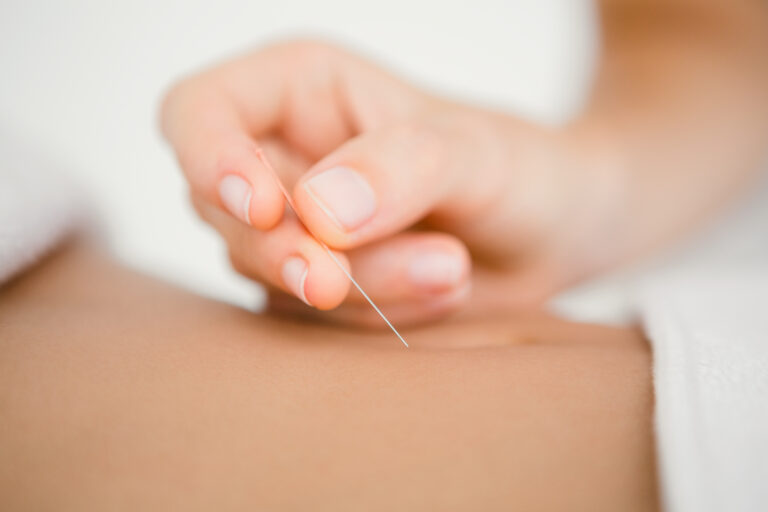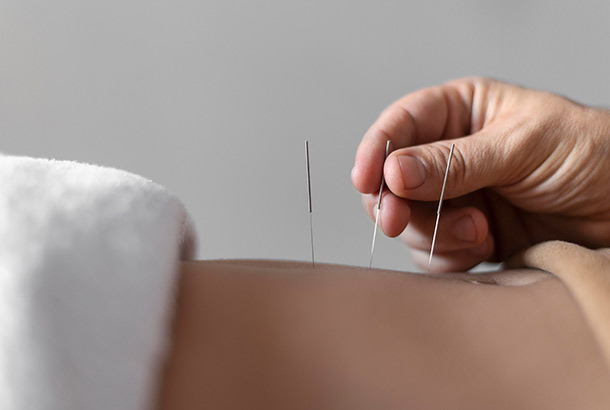Acupuncture
Acupuncture treatment is a practice that nurtures mental wellbeing and physical health. Rooted in Chinese medicine, the holistic treatment works to harmonise the body’s natural energy, making it more balanced and offering support for overall wellbeing.
What is Acupuncture?
Acupuncture treatments are derived from traditional Chinese medicine and involve the precise insertion of ultra-thin needles into specific points on the body. While it is widely recognised for its effectiveness at relieving pain, acupuncture treatments are also effective for promoting overall wellness and aiding in stress management.
Chinese medicine explains acupuncture as a technique which restores balance to the body’s energy, or “life force”, which is believed to flow along pathways known as meridians. By targeting these specific points, acupuncture helps rebalance energy flow, supporting both physical and emotional health.


Is Acupuncture right for you?
Each year, 2.3 million traditional acupuncture treatments are carried out in the UK, making this one of the most popular complementary therapies. People seek acupuncture for a variety of conditions, from chronic illness to part of a health maintenance regime.
Research shows that acupuncture can be an effective treatment for a wide range of conditions such as Allergic Rhinitis, Anxiety Disorders, Chronic Fatigue Syndrome, Depression, Fibromyalgia, Gastrointestinal Tract Disorders, Gout, Headache/Migraine, Hypertension, Infertility, Insomnia, Irritable Bowel Syndrome (IBS), Menopausal Symptoms, Musculoskeletal Conditions, Stress and Type II Diabetes.
Acupuncture treatment services we provide
- Moxibustion
- Auricular Acupuncture
- Guasha therapy
- Tuina Massage
- Cupping therapy
- Electro Acupuncture
- Chinese Dietary Therapy
Your initial Acupuncture consultation
At your initial acupuncture consultation with us, information including current signs and symptoms, full medical history, digestive system, circulatory system, sleeping patterns, diet and lifestyle will be taken so that we can facilitate a treatment plan that is designed specifically for you. As part of the overall diagnosis, looking at your tongue in addition to feeling pulses on both wrists will also be included.


During your Acupuncture treatment procedure
Acupuncture points are located around different areas of the body, which mean points aren’t always directly located near the area of your pain. Your acupuncturist will tell you the area of the planned acupuncture treatment, with the acupuncture needles being inserted at various depths.The needles are very thin, so insertion can often cause small discomfort, however some people often don’t feel them being inserted at all!
During your acupuncture treatment, the needles will remain inserted for around 10 to 15 minutes whilst you lie still and relax. There is usually no discomfort when the needles are finally removed.
How many Acupuncture treatments do you need?
The amount of acupuncture treatments required depends entirely on the condition being treated. Patients are normally seen once a week to begin with. Change is commonly felt by the patient within five or six treatments, although at times just one or two treatments suffice.
As a guide, acute conditions could require only a few sessions, whereas chronic conditions may take longer to improve. When acupuncture needles are inserted, you may feel a dull ache, tingle, warmth or pulling sensation. All needles are single-use, sterile and disposable.
As points most commonly used are located on the lower arms and legs, it is useful to wear loose, comfortable clothing.

Benefits of our Acupuncture treatment services
- Allergy relief
- Sleep improvement
- Pain relief
- Increased energy
- Stress reduction
- Digestion improvement
OLD TEXT Other therapies our acupuncturists use include
Moxibustion is prepared from leaves of Artemesia Vulgaris Latiflora and has a warming effect on acupuncture points and meridians.
Guasha Therapy stimulates Qi and Blood flow through the meridians.
Cupping Therapy is used over acupuncture points, meridians, muscles and/or joints to alleviate pain from Qi and Blood stagnation.
Auricular Acupuncture is the use of small acupuncture needles and/or the application of small seeds on ear points.
Tuina Massage stimulates acupressure points, opens energy meridians and stimulates the flow of Qi improving wellbeing.
Electroacupuncture is the stimulation of acupuncture points by a small low frequency electrical current (1Hz) of impulses passing between two needles.
Chinese Dietary Therapy is nutritional advice that supports us as we grow and progress through life requiring adjustments to proportions of various foods, in addition to amounts and variety of foods through the four seasons
Acupuncture FAQ's
Acupuncture is widely acknowledged as one of the safest forms of medicine. Acupuncture needles are pre-sterilized, individually packaged, and disposable which means there are minimal hygiene concerns. Acupuncturists also undergo extensive training and are regulated by the individual states’ medical board.
One of the greatest advantages of having acupuncture treatments is that it has little to no side effects. Occasionally, a small, temporary bruise may appear at the site of an acupuncture needle. When compared to the laundry list of cautions and side effects for the average pharmaceutical drug, acupuncture is very low risk!
Acupuncture is effective for treating both mental and physical ailments and can be used to treat overall wellbeing as well as physical pain. This includes migraines, back aches and arthritis. Studies have also shown that acupuncture treatment is a great option for a variety of conditions, including, arthritis, immune system issues, infertility and the effects of menopause. Acupuncture can also help other things such as anxiety, depression, insomnia and neurosis.
The frequency of acupuncture treatments depends on your medical condition. One of the benefits of the payment sliding scale is that it allows patients to come in frequently, often two to three times per week.
Many conditions respond faster to frequent acupuncture treatments, while other patients only need to come in once a week. Once your condition is stabilised, you won’t need to come in as frequently. When you come in for your first treatment, we’ll formulate a specific treatment plan for you so we can manage expectations.
While there are over 400 recognised acupoints, here are five commonly targeted points with their associated benefits.
- L14 (Hegu) – Location: On the hand between the thumb and index finger.
- ST36 (Zusanli) – Location: Below the kneecap, about four finger widths down and one finger width to the outer side of the shinbone.
- SP6 (Sanyinjiao) – Location: On the inner leg, about three finger widths above the ankle bone.
- GV20 (Baihui) – Location: On the top of the head, in line with the ears.
- PC6 (Neiguan) – Location: On the inner forearm, about three finger widths from the wrist crease.
No, the needles do not hurt. In fact, most people barely feel anything when needles are inserted. Some people feel a slight pinch, and others often don’t notice the needles going in as acupuncture needles are solid, flexible, and very, very thin (about the width of two hairs).
There are certain sensations associated with the therapeutic effects of acupuncture. These may include slight cramping, heaviness, distention, tingling or electric sensation traveling along a meridian. If any discomfort is experienced, it is usually mild and temporary.
How far acupuncture needles go depends on a few things which include where the needle is being inserted, what the purpose of the point is, and how much tissue is around the point. Your acupuncturist will insert the needles at various depths – from a fraction of an inch to a couple of inches. The needles will stay in for anywhere between a few minutes or as long as 20 minutes.
Some people may experience immediate relief, while others may need regular acupuncture treatments for a few weeks. Commonly, change is felt by the patient within five or six acupuncture treatments. Signs that acupuncture is working for you include feeling drowsy, relaxed and tingling throughout the body.
Dry needling and acupuncture both involve inserting fine needles into the body, but differ in their approach and purpose.
Acupuncture, rooted in traditional Chinese medicine, focuses on balancing the body’s energy by stimulating different points to promote overall health and address a variety of conditions. In contrast, dry needling is a modern technique grounded in Western medicine, targeting myofascial trigger points (tight knots in muscles) in order to relieve pain and improve mobility.
Acupuncture is a highly effective and safe alternative for treating sciatica. Acupuncture treatment helps by improving blood flow, reducing inflammation and promoting the release of endorphins. It is often used as a complementary treatment alongside physical therapy or other interventions.
Yes, you can have acupuncture treatments during IVF. Acupuncture can even improve the IVF outcome by decreasing blood flow independence and increasing the uterine blood flow. Both relaxation and stress relief play a huge role in the success of IVF treatments, and acupuncture helps boost this.
The tiredness you may feel after your acupuncture treatment is due to your body telling you that it’s depleted and needs to rest. It’s 100% normal to feel tired after your sessions and is a part of the healing process.
Unsure if Acupuncture is right for you? Get in touch using the form or call one of our clinics to speak with us
Corsham Clinic: 01249 248392
Swindon Clinic: 01793 978270

